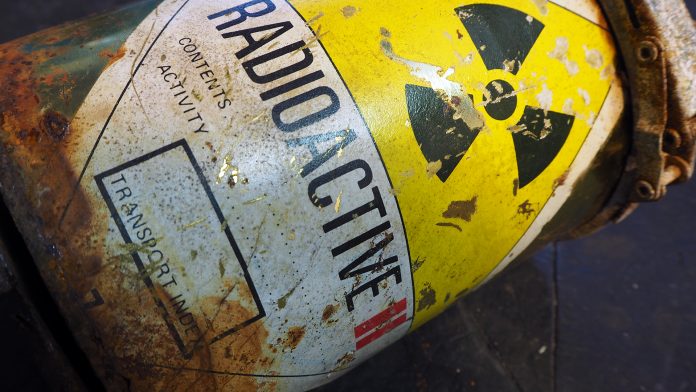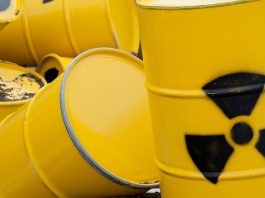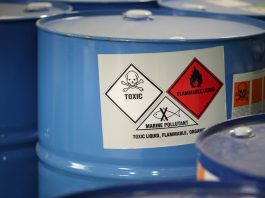The safe management of nuclear waste requires a sound scientific understanding of the various radioactive materials involved.
Radioactive wastes arise throughout all stages of the nuclear fuel cycle, as well as from a variety of other sources, such as industrial and medical applications of radioisotopes and research or in industries handling and processing naturally occurring radioactive materials (NORM). Research for the safe management of radioactive wastes is multidisciplinary and international. It comprises research and development (R&D) activities focusing on aspects relevant prior to waste disposal (pre-disposal research), as well as aspects of its disposal in near surface or deep geological repositories (waste disposal research), each with specific challenges, respectively. Several decades of research worldwide have contributed to established routines on how to handle most of the generated radioactive wastes (treatment, conditioning) and (near) surface disposal facilities for low and intermediate-level radioactive wastes have been in operation in various countries for decades. The first deep geological repositories for highly radioactive wastes will start operating within this decade.
Here, selected aspects of the scientific basis for the management and, ultimately, deep geological disposal of radioactive wastes will be outlined with a focus on nuclear and (waste) materials chemistry aspects, as they are in the focus of the research activities at Forschungszentrum Jülich (Institute of Energy and Climate Research (IEK-6): Nuclear Waste Management).
This research is aimed at closing knowledge gaps in the scientific basis for the safety of deep geological disposal and finding/optimising tailormade solutions for treating/recycling and conditioning specific waste streams prior to their disposal. Specific features of the pursued research approach on materials relevant for the safe management of nuclear wastes comprise:
- Complementary innovative experimental approaches (e.g., microfluidics) and advanced simulations at various length and timescales (e.g., atomistic and quantum chemical simulations, nuclear simulations, cross-scale reactive transport simulations, etc.) by using high-performance computing and data science approaches;
- Use of micronised radioactive sample materials for facilitation of experiments; and
- Application of state-of-the-art microscopic and (micro)spectroscopic methods (e.g., focused ion beam/scanning electron microscopy (FIB/SEM), transmission electron microscopy, atom probe tomography) (Bosbach et al., 2020).1
Most of the work forms an integral part of the research programme Nuclear Waste Management, Safety and Radiation Research (NUSAFE) of the Helmholtz Association of German Research Centres, plus additional (project) funding from the German government. It also contributes to European collaborative projects, such as the European Joint Programme on Radioactive Waste Management (EURAD).
Pre-disposal research: Focus on problematic nuclear wastes
For the major waste streams arising during operation, decommissioning and/or dismantling of nuclear installations, appropriate and safe management solutions prior to their disposal have been established during the last decades. However, some typically small ‘problematic’ nuclear waste streams remain that pose specific challenges regarding their characterisation, treatment/conditioning, and/or disposal, such as irradiated nuclear graphite, spent ion exchange resins, or irradiated toxic metals like beryllium, cadmium, or mercury. For these waste streams, further R&D work is required to support the development of integrated safe and sustainable management solutions, considering both radiological and non-radiological hazards. In many cases, a prerequisite for the establishment of integrated treatment/disposal strategies is an in-depth understanding of:
- Radionuclide sources, inventories, and speciation in the specific waste streams; and
- The radionuclide release mechanisms from the solid wastes or waste forms and the of the released radionuclide species.
One lesson learned from past research activities is that, in many cases, a mechanistic process understanding of the materials’ behaviour on a molecular level is essential, whereas phenomenological descriptions of the waste behaviour were often not sufficient to understand the radionuclide behaviour during treatment or under disposal conditions. In the R&D activities at Forschungszentrum Jülich on ‘problematic’ nuclear waste streams, fundamental studies on materials and radionuclide behaviour, as well as bottom-up approaches using model substances/materials to unravel specific effects, are therefore pursued, complementary to studying complex, real wastes and waste forms.
Example: Radioactively contaminated and activated mercury
Liquid metallic mercury has been used in a number of (historic) nuclear applications, for example as coolant for early experimental fast reactors, as shielding material in prototype fast reactors (e.g., the Dounreay Fast Reactor and the Prototype Fast Reactor at Dounreay, UK), as sealant material in hot cell facilities, and as a catalyst in isotope separation and uranium metal fuel dissolution (e.g., IAEA 2006).2 Moreover, liquid mercury has been and is still employed as target material in spallation sources in research accelerator facilities, such as the Spallation Neutron Source (SNS) in Oak Ridge, Tennessee, US, or the JESSICA facility at Forschungszentrum Jülich. Throughout these applications, mercury can become radioactively contaminated and/or activated and is classified as radioactive waste accordingly.
In Germany, disposal of radioactively contaminated metallic mercury waste faces significant challenges. Specifically due to the high chemotoxicity and mobility/volatility of most mercury compounds, only relatively small amounts of such wastes can be disposed of in the German Konrad repository for low and intermediated level radioactive wastes, because of regulations regarding groundwater protection.
Recently, a comprehensive management concept for mercury and mercury-containing waste streams from nuclear facilities has been developed in the framework of the PROMETEUS (PROcess of radioactive Mercury Treatment under EU Safety-Standards) research project, funded by the German Federal Ministry of Education and Research (BMBF, Grant agreement number 15S9266A-B) with a focus on:
- Acceptance criteria with respect to radionuclide inventory;
- Determination of the radionuclide inventory; and
- Radionuclide separation and treatment of remaining mercury wastes.
The project was stimulated by a decommissioning project at Forschungszentrum Jülich, where 600kg of radioactively contaminated mercury had to be managed – a perfect test case for the scientific outcome of the PROMETEUS project.
A characterisation concept was developed, and various decontamination techniques for mercury were tested. The radioactive residues could be easily removed by different techniques (e.g., vacuum distillation, washing with different acidic solutions), and the elemental mercury could thus be decontaminated. A clearance concept was developed to release the decontaminated mercury from regulatory control. A gamma spectrometric measurement setup was built, and the general feasibility of the decontamination procedure, followed by the clearance of mercury, was demonstrated on real mercury waste quotas. The radiological characterisation/measurement of radioactive mercury is challenging due to the high density (13.5 kg L−1) and shielding effects. The gamma-spectrometric measurements were supported by nuclear simulations based on the neutron and particle transport code MCNP® to determine the photo peak efficiencies for the measurement of radioactively contaminated mercury samples under conservative assumptions. Such conservative conditions are mandatory for possible clearance measurements to preclude an underestimation of the activity in the sample. The concept is described in Klass et al. (2021).3
Treatment options were also examined for the radioactive, mercury-containing residues including the encapsulation in a waste matrix and examination of the stability of these waste forms. The suitability of the highly insoluble mercury sulphide as waste form was demonstrated in leaching experiments. Further mercury-containing wastes from nuclear facilities in Germany are expected, most of them with comparably small volumes. However, these wastes still have to be dealt with.
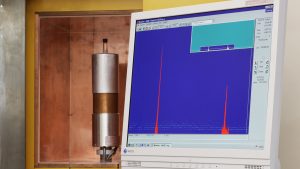
A new management concept for the decontamination of radioactively contaminated mercury was successfully implemented at Forschungszentrum Jülich, aiming at either its reuse (inside or outside of nuclear applications) or its disposal as conventional waste, while the residues from the decontamination process (including most of the radionuclide inventory) would be disposed of as radioactive waste. Thus, a large amount of the mercury waste could be either recycled or handled as conventional hazardous purely chemotoxic waste, leading to a significant reduction in the radioactive waste volume for disposal.
Waste disposal research: Solid solutions and the long-term safety
The safe disposal of radioactive waste requires its isolation from the geo-/biosphere until radioactive decay has reduced its radiotoxicity to innocuous levels. Based on several decades of research, development, and demonstration (RD&D), it is generally accepted at the technical and scientific level that disposal in mined deep geological repositories (i.e., at depth exceeding 500m below ground level) is the safest and most sustainable option for the management of high-level radioactive wastes (HLW, e.g., vitrified wastes from the reprocessing of spent nuclear fuels) or spent nuclear fuels (SNF), if considered as waste.
The long-term isolation and containment of the radioactive wastes in a geological disposal facility is achieved through a multiple-barrier system, combining manmade engineered barriers, including durable waste forms, metallic waste containers as well as buffer and backfill materials, with a suitable geological barrier, the repository host rock. The host rock types envisaged for deep geological disposal of HLW and SNF vary among countries, but the main options are crystalline rocks (e.g., granite), clays and clay rocks, or salt rocks. The HLW/SNF containers emplaced in deep geological repositories in clay formations or crystalline rocks will inevitably come into contact with groundwater some time after the closure of the repository.
Even in repositories in salt rocks, the presence of water cannot be completely ruled out in less likely scenarios. As a consequence, upon contact of groundwater complex dissolution/corrosion processes will be induced, resulting in the potential release of radionuclides from the waste with (ground)water being the principal pathway by which radionuclides can be transferred from the waste into the environment. Therefore, the interactions between the radioactive wastes and water, as well as the mobility of dissolved radionuclides, have been studied extensively over several decades. One important result of this research is that most long-lived radionuclides have a very limited mobility within the repository system and only a small number of long-lived fission and activation products (e.g. 14C, 36Cl, 79Se, 99Tc, 135Cs) as well as some decay products (e.g. 226Ra) show a rather high solubility and limited ability for adsorption and consequently little retention.
Example: Retention of radium within the repository system by solid solution formation
Many materials relevant for the management of nuclear wastes are not pure substances but solid solutions that exist over a wide range of chemical compositions. Radionuclide containing solid solutions relevant to the deep-geological disposal of high-level radioactive waste include: (1) primary phases (waste forms), such as spent nuclear fuels, borosilicate glass, single phase/multiple phase ceramic waste forms; and (2) secondary (alteration) phases forming during the long-term evolution of a repository system, including alteration phases forming during waste form corrosion, iron (container) corrosion phases (green rust, magnetite), and cement phases (e.g. calcium-silicate-hydrates, CSH) in cementitious barriers. Substitutional solid solutions form by the replacement of one atom by another atom. A disordered arrangement of different atoms over the same lattice is stabilised by the entropy.
226Ra has been identified as one of the radionuclides with a major contribution to the dose potentially released from a repository system containing directly disposed spent nuclear fuel. The tendency of solid solution formation with BaSO4 is known for more than 100 years. The particular challenge is the quantitative description and a mechanistic process understanding for the application in safety cases.
Here, an interdisciplinary approach was applied, focusing on the material properties of the (Ba,Ra) SO4 solid solution where 226Ra substitutes for Ba without changing the atomic scale structure. A combination of batch-type laboratory experiments was complemented by state-of-the-art analytical techniques, atomistic simulations, and thermodynamic modelling approaches. Ultimately, an advanced thermodynamic model for this solid solution – aqueous solution system was derived and validated allowing for a refined prediction of Ra solubility in a repository system, controlled even by the ternary (Ba, Sr, Ra)SO4 solid solution (Brandt et al., 2020).4 The results have been successfully implemented in safety assessment studies for deep geological repositories in Finland, Sweden, and Switzerland.
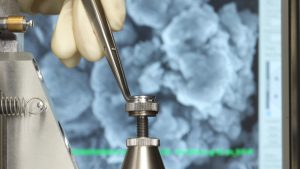
This research has concluded an open issue in radiochemistry since the discovery of radium by Marie Curie at the end of the 19th century by taking a multidisciplinary approach using state-of-the-art experimental, analytical, and simulation techniques to create a substantiated framework to predict upper (solubility controlled) radium concentrations.
Perspective
During the last ten years, various tailored destructive and non-destructive radioanalytical techniques, waste treatment procedures, and radionuclide separation protocols have been developed to provide solutions for the management of problematic radioactive wastes. Basically, an application-oriented toolbox for the management of such wastes. It seems clear that excellent research in this context will continue to offer solutions for the remaining open issues but will also enable future optimisation.
Furthermore, filling the remaining knowledge gaps for the scientific basis of the safety case of geological disposal of radioactive wastes also highly depends on excellent research – ideally by integrating experiments and simulations. Materials research is an essential element in the provision of the knowledge base for the assessment of the (long-term) evolution of a repository system and thus contributes to the scientific basis of the safety case.
By integrating innovative experimental approaches and advanced simulation methods (at various length and timescales), several open issues with respect to the behaviour of (waste) materials have been successfully addressed at Forschungszentrum Jülich in recent years. Furthermore, the organisation of co-ordinated research programmes at national and international level, such as those carried out in the Helmholtz Association in Germany (NUSAFE programme including Forschungszentrum Jülich) or the European Joint Programme for Radioactive Waste Management (EURAD), are very successful developments in this regard.
Finally, research for the safe management of radioactive wastes crucially depends on the availability of experts. Therefore, developing competence in nuclear and training of the next generations of experts is an important aspect. At Forschungszentrum Jülich, 46 students went through a PhD programme, finishing their dissertation in the context of nuclear waste management since 2009.
References
- Bosbach, D. , Brandt, F., Bukaemskiy, A., Deissmann, G., Kegler, P., Klinkenberg, M., Kowalski, P., Modolo, G., Niemeyer, I., Neumeier, S., Vinograd, V., Research for the safe management of nuclear waste at Forschungszentrum Jülich: Materials Chemistry and Solid Solution Aspects Advanced Engineering Materials 22(6), 1901417 (2020) [10.1002/adem.201901417]
- International Atomic Energy Agency (IAEA), Management of problematic waste and material generated during the decommissioning of nuclear facilities. Technical Reports Series 441, Vienna, Austria, (2006)
- Klass, L., Ritz, P., Hirsch, M., Kettler, J., Havenith, A., Wilden, A., Modolo, G., Gamma-spectrometric measurement procedure for a clearance concept of radioactively contaminated mercury from nuclear facilities, Journal of Radioanalytical and Nuclear Chemistry 329, 565–580 (2021) [10.1007/s10967-021-07840-7]
- Brandt, F., Klinkenberg, M., Poonoosamy, J., Bosbach, D., Recrystallization and uptake of 226Ra into Ba-rich (Ba,Sr)SO4solid solutions. Minerals 10 (9) 812 (2020) [10.3390/min10090812]
Please note, this article will also appear in the thirteenth edition of our quarterly publication.

